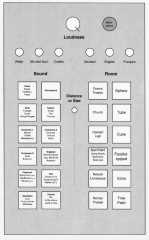Content Description
ARCHITECTURE AND MUSIC
Since early times there is a close relationship between sounds and spaces, the mankind has made buildings in order to get a specific acoustic, whereas it has composed music to be heard in a given space. From the basis that a sound will be always related to its environment, we can “see” different rooms or spaces by listening to them. This acoustical impression of a room can be seen as its own signature, a distinctive property. This fact leads us to describe a room either with a visual image or with a sound image, and the sum of these two images builds up the global room perception. Inside an ancient cathedral, we can marvel at watching its walls and rose windows, but also listening to the footsteps resounding in the silence. In many spaces the acoustical factor does not stand at the forefront of the design criteria, and it only acquires relevance for performance spaces, i.e. concert halls or auditoria, which are supposed to have good acoustics. In other words, the idea that only these special performance spaces “have” acoustics should be further clarified. When talking or singing, we listen to our voice but also to the room, and it will sound different whether it is a bathroom or a living-room. Of course, this is an important factor that makes people sing in the bathroom rather than in the kitchen. The space contribution in a sound is the socalled Reverberation, and the sound image mentioned before is called Reverberation pattern. It allows to describe
objectively a room. There are many different rooms, and only trained people are able to identify a particular space just by listening to its reverberation. However, the kind of room can be easily perceived with the eyes shut and by producing a short sound, for instance, clapping one’s hands. Making this test, we can assure if it is a large hall, a church, a small room, or an open-air space. A similar procedure is used to describe objectively a room by recording its reverberation pattern and using measurement equipment. In the field of room acoustics, the aim would be to model the sound field inside a room, and it would allow to know before-hand the quality of an auditorium, or to synthesize artificial reverberation of particular rooms. This last method is also used for the simulation of virtual environments. The architecture defines above all the visible space, but this architecture brings at the same time specific sonic properties, due to the geometrical shapes and materials used. The pair (sound, space), is the basis for the AML. Further, from an artistic point of view, a space can be considered as architecture and a sound can be the first element of a piece of music, this leads to the name of this museum installation: Architecture and Music Laboratory.
(Jordi Janer and Pierre Dutilleux)
INSTALLATION
The components of the installation AML Architecture and Music Laboratory can be divided into four parts, the user’s interface, the sound source, the reverberation system and the amplification. The visitor controls via the interface which sound should be combined with which selected space. The signal resulting from these choices is amplified and presented to the visitor by the mean of headphones. We have chosen to use headphones instead of loudspeakers for several reasons:
- headphones give a better calibrated reproduction, with no additional reverberation due to the listening room;
- the listeners can better concentrate on the sounds because they are acoustically isolated can be fairly high when many interactive installations are simultaneously in operation;
- the large available dynamic range enables the visitors to perceive the fine structure of the reverberated signals;
- each headphone can be set at a different reproduction level in order to suit the differing expectations of the visitors;
- the contribution of the AML to the level of background noise of the museum is kept at a minimum. Additionally the visitor should get the illusion that the source of the sound is always coming from the same location in space, although he moves his head. Therefore a tracking-sensor is integrated in the headphone, which measures the position and the direction of the visitor’s head.
(Pierre Dutilleux and Christian Müller-Tomfelde, 1999)
GRAPHICAL USER INTERFACE
The installation AML Architecture and Music Laboratory is driven by a Graphical User Interface, where the visitor selects a sound and a room among several buttons. (See Fig. AML_GraphicalUserInterface)
On the left side, the sounds are provided in different groups and a microphone allows to listen to the visitor’s voice. The imitated rooms are separated in two groups on the right side: Complex and Basic Shapes. The Complex Shapes reproduce real rooms that were previously measured such as a church, a roman theatre in Orange or a bath-room; and the so-called Basic Shapes imitate geometrical figures such a cube, a sphere or a cylinder. Apart from selecting the sound and the room where it is performed, another parameter can be specified by the user with the central slider. This parameter sets the distance for the Complex Shapes and the size for the Basic Shapes, specified in meters. In the first case, by moving the slider up, the visitor goes away from the sound source. For the Basic Shapes, the figure grows creating an impression of a larger space. The sounds were recorded, as far as possible, in an anechoic environment (without any reverberation), and the reverberation is processed in real-time. Selecting the Free Field room, the visitor can listen to the original sounds. More information about the current sound and room can be displayed by clicking on the Info button.
(Jordi Janer and Pierre Dutilleux)


